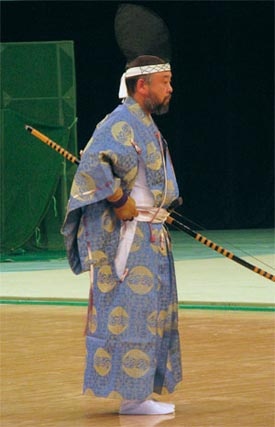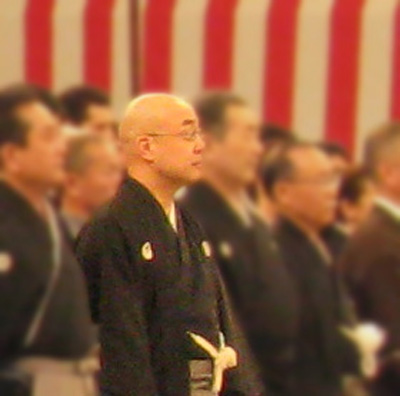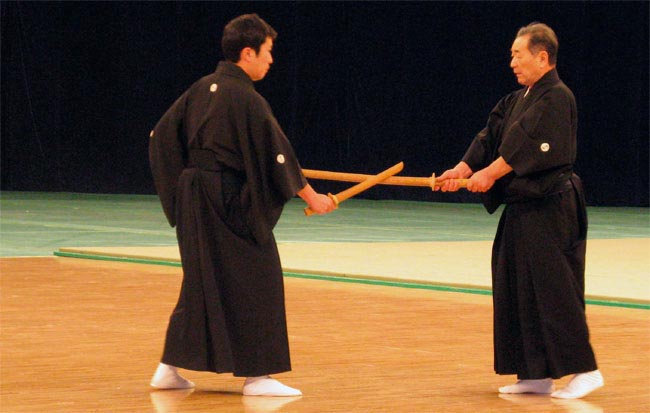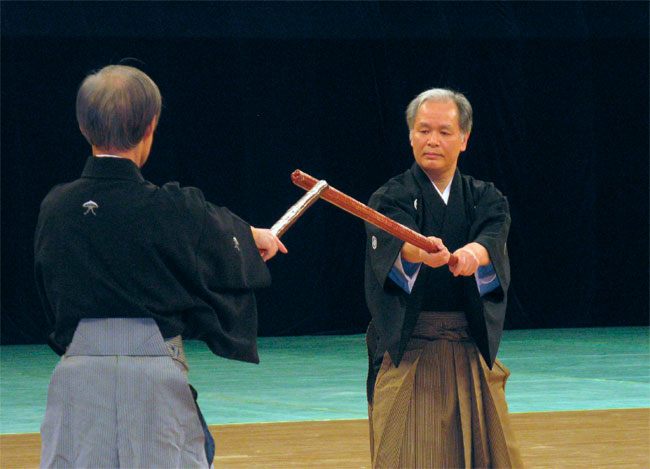The Nihon Kobudo Kyokai celebrated its 30th anniversary in 2009, and also held its 32nd event in Tokyo (in some years, more than one event was organized). Co-sponsored by the Nihon Budokan, the demonstration occurs annually at the Nihon Budokan in Tokyo, or occasionally in other venues around Japan. Schools demonstrate by invitation only, and most members participate every two years.
In total, forty schools participated in this 32nd event. Since we were also fortunate enough to participate, I updated my notes on these forty schools and decided to present them in a series of four parts, illustrated with some photos taken during the event by two of my students. I don’t pretend to be complete in the information (in fact no-one can write “a complete guide” to something). Indeed, there is much better information available (including on the Koryu.com website or in one of the books published by Koryu Books) on some of the individual schools. Nevertheless, this overview attempts to be complete in the sense that it covers all the schools that participated.
In this part, I describe the first ten participating schools:
- Ogasawara-ryu kyubajutsu
- Tenshinsho-den Katori Shinto-ryu kenjutsu
- Kurama-ryu kenjutsu
- Tatsumi-ryu heiho
- Bokuden-ryu kenjutsu
- Yagyu Shinkage-ryu hyoho kenjutsu
- Ono-ha Itto-ryu kenjutsu
- Jigen-ryu hyoho kenjutsu
- Heiho Niten Ichi-ryu kenjutsu
- Shingyoto-ryu kenjutsu
Ogasawara-ryu kyubajutsu is an archery school, the other nine are kenjutsu schools.
Ogasawara-ryu kyubajutsu
小笠原流弓馬術

| Location: | Kugenumakaigan, Fujisawa-shi, Kanagawa-ken |
| Origin & lineage: | The Ogasawara-ryu was established in 1187 and the succession of the archery school has passed from father to son since the establishment of the Kamakura shogunate. |
| The first patriarch, Ogasawara Nagakiyo, was born in Koshu (nowadays Yamanashi prefecture) in 1162; his father was Kagami-jiro-tomitsu. The surname “Ogasawara” was provided by the Emperor Takakura. Ogasawara Nagakiyo was the personal equestrian archery and martial tutor of Minamoto Yoritomo, the prominent and powerful military general of the Kamakura shogunate. In 1880, the 28th patriarch, Ogasawara Kiyokane, opened the Ogasawara school of etiquette and horsemanship to the public. The 31st patriarch is Ogasawara Kiyotada. | |
| Description: | Kisha is the school’s equestrian archery technique. It originated as mounted archery and later came to be performed as a ritual ceremony. Yabusame is the ceremony in which archers wear full formal hunting outfits of the Kamakura era (a-ge-shozoku). Riding rapidly on horseback, they must shoot three targets set up along a straight riding track (about 250m). Hosya refers to Japanese archery techniques on the ground (not on horseback). |
Tenshinsho-den Katori Shinto-ryu Kenjutsu
天真正伝香取神道流剣術

| Location: | Katori, Katori-shi, Chiba-ken |
| Origin & lineage: | One of the oldest koryu. Founded by Iizasa Ienao (a respected spear and swordsman, who lived near Katori Shrine) in 1447. The 20th generation headmaster is Iizasa Shuri-no-suke Yasusada, but the representative, and head instructor on behalf of the headmaster, is Otake Risuke. |
| Description: | Although categorized by the Nihon Kobudo Kyokai as a kenjutsu school, Katori Shinto-ryu has a large curriculum, which also includes iaijutsu, ryotojutsu (art of using both long and short sword at once), bojutsu, naginatajutsu, sojutsu, shurikenjutsu and even some jujutsu. For a comprehensive overview readers are referred to the book Katori Shinto-ryu: Warrior Tradition by Otake Risuke himself. Also in the “Koryu.com Guide to Classical Japanese Martial Arts.” |
Kurama-ryu kenjutsu
鞍馬流 剣術

| Location: | Shinano-machi, Shinjuku-ku, Tokyo-to |
| Origin & lineage: | Founded in the Kyoto area by Ono Shokan in the late 16th century. Present headmaster is Shibata Akio (18th soke) who succeeded Shibata Tetsuo. |
| Description: | Kenjutsu school; despite of consisting of only a few kata, the school concentrates on efficiency. Although the school itself might be less known by Westerners, some practitioners will have come across a bokuto from Kurama-ryu (the wooden tsuba is characteristic), sold in several budo shops. 
|
Tatsumi-ryu heiho
立身流兵法

| Location: | Chuo, Chuo-ku, Chiba-shi, Chiba-ken |
| Origin & lineage: | Founded in the early 16th century by Tatsumi Sankyo. In the 17th century, the school was recognized as the official style (otome ryu) of the Sakura Domain (in present-day Chiba prefecture). Current headmaster is Hiroshi Kato. |
| Description: | Kenjutsu school with a large curriculum of other techniques, including jujutsu (called yawara). The sword is also used against yari, naginata, rokushaku-bo, and hanbo. More insight can be found in the article “Kato Takashi: Reflections of the Tatsumi headmaster” in Koryu Bujutsu. Tatsumi-ryu kenjutsu is also covered in the “Field Guide to the Classical Martial Arts” in the book Sword and Spirit and in the Koryu.com Guide to Classical Japanese Martial Arts. |
Bokuden-ryu kenjutsu
卜傳流剣術

| Location: | Kasuga-cho, Hirosaki-shi, Aomori-ken |
| Origin & lineage: | Bokuden-ryu kenjutsu was founded by Tsukahara Bokuden (1489-1571), a student of Tenshinsho-den Katori Shinto-ryu. Bokuden was a famous swordsman who served as an instructor of Shogun Yoshiteru Ashikaga and who initially called his system Mutekatsu-ryu (“the school of winning without hands”). There is a famous story of Bokuden who was not taken seriously for this style and got challenged. He agreed to have a fight but proposed to have it on a small island (on Lake Biwa) to avoid being disturbed by others. When the challenger jumped from the boat, Bokuden pushed the boat back, leaving him on the island. From a safe distance he shouted that this was a technique of his school of “winning without hands” This anecdote even served as model for a scene in a Kung-fu movie (Enter the Dragon with Bruce Lee). The name Shinto-ryu Bokuden-ryu (or abbreviated Bokuden-ryu) was introduced by the second headmaster, Bokuden’s nephew Ishii Bokuya. Current headmaster is Koyama Hidehiro. |
| Description: | Primarily a kenjutsu school, but the 13th generation headmaster was also a master in Sekiguchi-ryu and incorporated some jujutsu into the curriculum. Note that another line originating from the art of Tsukahara Bokuden is also recognized by the Nihon Kobudo Kyokai under the name Kashima Shinto-ryu (now headed by Yoshikawa Tsuenetaka). This has been covered by Meik Skoss in “Kashima Shinto-ryu.” |
Yagyu Shinkage-ryu Hyoho Kenjutsu
柳生新陰流兵法剣術


| Location: | Nakahira, Tenpaku-ku, Nagoya-shi, Aichi-ken |
| Origin & lineage: | Founded by Kamiizumi Ise-no-Kami Nobutsuna (1508-1578), who studied the schools of Tenshinsho-den Katori Shinto-ryu and Kage-ryu before creating his own school, called Shinkage-ryu. The name was completed by the second headmaster, Yagyu Muneyoshi (1507-1606) and it became Yagyu Shinkage-ryu. In 1606, the school split into two branches. Yagyu Toshiyoshi (grandson of Yagyu Muneyoshi) took charge of the main line (Owari branch), while Yagyu Munenori (son of Yagyu Muneyoshi) became the head of a new Edo branch. Current headmaster of the mainline (Owari line) is Yagyu Koichi Toshinobu (22nd soke). |
| Description: | One of the first schools of kenjutsu of the Edo period (1603-1868). Until the 16th century, basic postures were very distinct: very low, in protection of the body. Kamiizumi changed the basic postures by raising them slightly, he changed the manner of holding the sword, and he shortened the length of the blade of the sword. He also invented the hikihada, a fukuro-shinai (ancestor of the modern kendo shinai). Yagyu Munetoshi’s son, Yagyu Munenori, served as kenjutsu teacher for the 3rd and 4th Tokugawa Shogun, Hidetada and Iemitsu. Takuan Soho, the famous priest, known for his concepts such as fudoshin, wrote The Unfettered Mind: Writings of the Zen Master to the Sword Master for Yagyu Munenori. Yagyu Shinkage-ryu hyoho kenjutsu is also covered in the “Field Guide to the Classical Martial Arts” in the book Koryu Bujutsu and in the “Koryu.com Guide to Classical Japanese Martial Arts.” |
Ono-ha Itto-ryu Kenjutsu
小野派一刀流剣術

| Location: | Daizawa, Setagaya-ku, Tokyo-to |
| Origin & lineage: | Itto-ryu branch, founded by and named after Ono Jiroemon Tadaaki (1565-1628), student and successor of Ittosai Kagehisa, creator of Itto-ryu. Sasamori Junzo (1886-1976), a well known and high ranking kendoka (author of the book This is Kendo) was the 16th headmaster; his son Sasamori Takemi, is presently the 17th headmaster. |
| Description: | Ono-ha Itto-ryu is the oldest surviving Itto-ryu style (one-sword school) that derives from the original Itto-ryu of Ittosai Kagehisa. Together with Hokushin Itto-ryu kenjutsu, Ono-ha Itto-ryu was a model for modern kendo kata. Note that Meik Skoss wrote an overview on Itto-ryu in the book Keiko Shokon. Also included in the “Koryu.com Guide to Classical Japanese Martial Arts.” |
Jigen-ryu Hyoho Kenjutsu
示現流兵法剣術

| Location: | Higashisengoku-cho, Kagoshima-shi, Kagoshima-ken |
| Origin & lineage: | Founded by Togo Chui (1561-1643) in the late 16th century in Satsuma Province (now Kagoshima prefecture in Kyushu). Togo Chui learned Tenshin Shojigen-ryu from a Buddhist priest named Zenkichi. He also studied Marume’s Taisha-ryu. Lord Shimazu nominated Togo Chui as an official master of martial art of the Satsuma han and encouraged him to promote Jigen-ryu as the domain’s official martial art. In 1609, Shimazu Tadatsune, Lord of Satsuma, together with his 2500 well-trained samurai invaded the Ryukyu Kingdom and forced King Sho Nei to surrender. Current headmaster is Togo Shigenori (12th generation). |
| Description: | Kenjutsu school known for its emphasis on the first strike (during practice, a long wooden stick is used to hit a vertical pole or tree). To illustrate the power of the Satsuma warriors, there is still often reference to the Battle of Toba-Fushimi, where many heads of dead samurai of the shogunate forces were found with the back of their own swords driven into their foreheads. They just could not defend against the attack of a Jigen-ryu samurai. The school is said to also have had some influence on Okinawa karate and the use of the makiwara could have originated from Jigen-ryu’s training method. In ancient times, Jigen-ryu was closed to outsiders and training sessions were kept secret. However Sokon Matsumura (1797-1899), an official in the Ryukyu government and shuri-te teacher of Itosu Anko (1831-1915), was one of the only inhabitants of Okinawa to be allowed to become skilled in Jigen-ryu kenjutsu. |
Heiho Niten Ichi-ryu kenjutsu
兵法二天一流剣術

| Location: | Yokoshiro, Kokuraminami-ku, Kitakyushu-shi, Fukuoka-ken |
| Origin & lineage: | Founded by the famous Miyamoto Musashi (1584–1645), who was the author of Go Rin No Sho (“The Book of Five Rings”) and Dokkodo (“The Way of Self Reliance”, usually translated as “Going My Way”). Imai Masayuki Nobukatsu, the 10th Headmaster of Heiho Niten Ichi-ryu (heiho can also be read as hyoho) created an annotated text with explanations of Dokkodo. The current (11th generation) headmaster is Iwami Toshio Gensho. |
| Description: | Kenjutsu school, mainly known for its two-sword (katana and wakizashi) techniques called nito ichi “two swords as one” (or niten ichi, “two heavens as one”). Nevertheless the school has many kata using only one sword (bokken). Heiho (or Hyoho) Niten Ichi-ryu kenjutsu is also covered in the “Field Guide to the Classical Martial Arts” in the book Koryu Bujutsu and in the “Koryu.com Guide to Classical Japanese Martial Arts.” |
Shingyoto-ryu kenjutsu
心形刀流剣術

| Location: | Higashi-machi, Kameyama-shi, Mie-ken |
| Origin & lineage: | Founded by Iba Josuiken Hideaki in the late 17th century. The name refers to the relationship of the heart or spirit (shin), the form (gyo), and the sword (to). Present headmaster is Kobayashi Masao. |
| Description: | Kenjutsu and iaijutsu but also naginatajutsu (with an iron cross bar). Shingyoto-ryu kenjutsu is also covered in the “Field Guide to the Classical Martial Arts” in the book Koryu Bujutsu and in the “Koryu.com Guide to Classical Japanese Martial Arts.” |
Copyright ©2009 Guy Buyens. All rights reserved.
